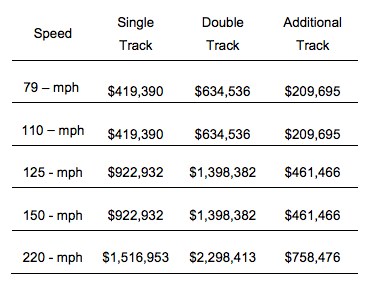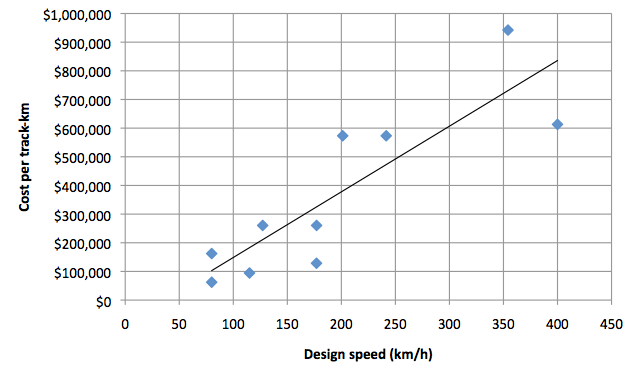Signalling and Control includes the systems set up to ensure safe operation of multiple trains, track switching, scheduling, and related systems. Some estimates also include “communications”, with expenses such as wi-fi basestations that allow on-board internet connectivity.
AECOM13 calculates signalling on a unit basis, rather than a per-km basis, which is probably sensible. The estimates which apply to fixed installations rather than rollingstock are:
[table]
Element,Cost,Unit,Frequency
Track crossover,$6m,Each,20km
Station crossover,$12m,Each,Every station
Balises (transponders),$2000,Per route-km,Entire length
Control Centre building,$35m,Each,Two in total
Control Centre equipment,$10m,Each,Two in total
Communications cable,$125k,Per route-km,Entire length except tunnel
Wi-fi/radio tower,$800k,Each,12km (rural) or 6.5km (urban)
Wi-Fi tunnel repeater,$500k,Each,500m (tunnels only)
[/table]
If we ignore the control centres and tunnel hardware and convert everything else to a per-km cost, and assuming a station frequency of 100km for the HSR system, it adds up to $490,000/route-km. But the total cost estimated in AECOM13 is $1.6 billion, or $915,000/route-km – almost twice as much! Perhaps we need to include the tunnel based wi-fi repeaters. AECOM13 specified 144km of tunnel (8% of the total distance), so that would add a cost of 0.08*$1m/km, or $80,000/km. Still not enough. Even if we guess that the $2000/km for transponders was a typo that actually meant to read $200,000/km, it still only adds up to $770,000/km (this is unlikely – balises are very simple devices). Yet again, AECOM13 does not seem to support its own cost assumptions.
Other estimates
Still, let’s take $915,000/dual-km as a datapoint for a 400km/h design speed, 0r $613,000/track-km assuming single track is two thirds the cost of dual. What other estimates can we find?
The Minnesota DOT provides cost estimates for the installation of a CTC system (centralised traffic control). It includes an overall estimate as well as individual components. Its estimates, converted to $/km from $/mile and assuming parity with the AUD, are:
- Install CTC System: $128,500/km (single), $210,500/km (dual)
- Turnout control point: $650,000 each
- Turnout/crossover control point: $1,296,000 each
- Universal crossover control point: $1,619,000 each
- Add turnout to existing control point: $452,000 each
- Add crossover to existing control point: $792,000 each
The University of Iowa study by von Brown (2011) gives estimates for signal costs versus design speed. To convert the following table to $/km, divide by 1.61. Von Brown’s estimates are actually substantially higher than AECOM13.
The Australian Rail Track Corporation estimated the replacement cost of the Australian network in 2007. The average cost of signalling and control was $43,259/track-km for signalling, and $9,711/track-km for communications (this converts to $50,921 and $11,431 in 2013 dollars). The highest cost was $75,137/track-km for signalling and $16,493/track km for communications in the Casino-Acacia Ridge project ($88,446 and $19,414 in 2013). This was for relatively low-speed track; assume a general top speed of 115km/h, or 80km/h for freight only.
A 2011 report on the Port Waratah Coal Loop freight line gave the following costs:
- Signals – $37,496 per unit
- Signal cabling – $108,706 per km
- Signal power supply – $53,628 per km
Summary
If we plot cost against design speed for the various estimates above, we obtain the following figure with its beguilingly linear trend:
The trend is assumed to be conservative, as the data plotted was for single track; dual track cost is lower on a per track-km basis. However it appears that the data is not actually a trend, but a series of step-changes. This is logical; we don’t design a unique control system for each individual speed, but rather a certain type of control architecture is suitable for a range of speeds. Based on the data here, we can identify four potential speed bands, and assumed costs for them:
- Less than 120km/h: $150,000/km
- 120-199km/h: $225,000/km
- 200-299km/h: $600,000/km
- 300km/h or greater: $900,000/km
It would be better to cost signalling and communication on an individual basis. For this we will go back to AECOM13 data, but multiply the cost per turnout or crossover by 0.67 to account for the lower design speed. Also, people can go without wi-fi when they are breifly within tunnels. Seriously.
[table]
Element,Cost,Unit,Frequency
Track crossover,$4m,Each,As needed
Station crossover,$8m,Each,Every station
Balises (transponders),$2000,Per route-km,Entire length
Control Centre building,$25m,Each,At terminal stations
Control Centre equipment,$7m,Each,At terminal stations
Communications cable,$125k,Per route-km,Entire length except tunnel
Wi-fi/radio tower,$800k,Each,10km (average)
[/table]
PS – the awesome manga of a high-speed train cockpit comes from Anomonny at DeviantArt. Love it.





